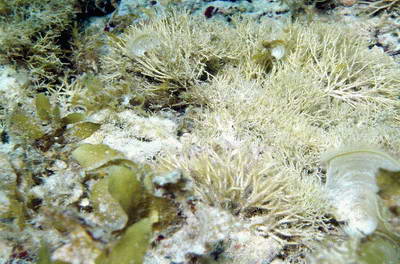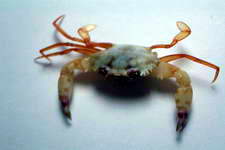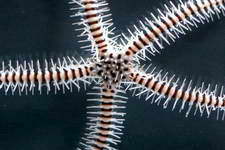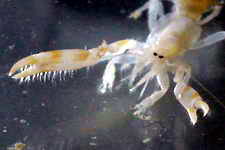
Since this area is never exposed during the low
tides, a
wide variety of macro algae can be found creating a carpet clinging
onto the numerous rocks and rubble. Within a ten square foot area,
there are numerous species of macro algae, although the
calurpa species are rarely, if ever found. The following species of
algae are the most commonly seen, Actinotrichia
fragilis, Galaxaura fastigiata, Gracilaria salicornia, Gracilaria
tikvahiae and Padina sp..
Mixed in amongst the previous species are quite a few other
species including the Halimeda and Bubble algae. All combined, makes
for a luxurious habitat for a myriad of small creatures.
A great number of worms, copepods, amphipods,
isopods as well as a good many crab and
shrimp species make up the bulk of the smaller animals. The more larger
species include the xanthid crab family, Mantis shrimp, along with a
good number of snails, of which most species are members of the Whelk
and Cone families, all predators. Very few snail herbivores are found,
which came as a surprise to me given the abundance of algae. Fish
species that make this area their home include the pipe fish, file
fish, small wrasse and of course the
ever present damsels.




Even with the vast amount of algae
competition, there are
still a few corals that can be found, somehow managing to get by. I say
that because not only do the corals found in this zone have to compete
with much faster growing algae, they also have to endure pretty harsh
conditions as compared to their brethren found in deeper waters.
Temperatures during the lulls between tides can easily reach close to
ninety degrees Fahrenheit as well as having to protect themselves
against a full days worth of ultra violet light. To make things even
more difficult, at low tides, a great many local people wander this
zone turning over just about every rock in search of edible animals.
What I found when I first arrived here had me
quite
puzzled, as I would turn over (and replace) rocks in my search for
specimens, I would find small corals and algae alive on the side of the
rock that was face down in the sand / rubble. This left me wondering
for quite some time until I realized that there are so many people
turning the rocks over every day, that each side of the rocks get their
turn in the sun. The corals and algae can somehow endure a day or two
of being in the dark and laying against the sand.
Being comprised of loose rubble and larger rocks, makes for a great
many crevices that are used as shelter and hunting grounds for a
variety of gobys, mantis shrimp and snapping shrimp species. Some areas
have so much rubble that it can be a few feet deep which sand has
stabilized to an extent by filling in the gaps further down.
This
still leaves a lot of open room between the rubble nearer the surface,
and as with any open room on a reef, it will be home to something one
way or another. Some animals enlarge and extend these gaps to suit
their own needs. Most notably the gobys. Whom I have seen create very
extensive networks of tunnels, usually always leading to a large
unmovable rock. I see this area as being much like a sand bed, only on
a much larger scale with its huge grains and equally large infauna.


A large sea hare which hides under rocks during daylight & A
sponge species that is tolerant to air exposure at low tides
There are also patches of area that do not have such rubble, yet are at
the same depth and distance from shore, comprised of exposed lava base
rock that has been colonized by a number of coral species. A mini coral
reef if you will. Keeping with the mini theme, the lava substrate has
small formations that jut upwards much like the larger outcroppings on
the coral reef. Each of these mini outcroppings can hold a few coral
species yet the majority of them can only sustain a single species, and
again, all in a mini form as there is no where else to grow
horizontally and the shallow depth limits any upward growth. Between
these features are bare sand areas no more than a few inches deep. Not
much visible life to be found in this shallow sand other than a few
olive snails and the odd polychaete worm.


Of
course this rocky and rubble strewn area is filled with what I know as
being called live rock. I have on many occasions brought home a few
rocks at a time from this area, to explore what life can be found
living on as well as in such rocks. I believe I will never get over the
amazement of seeing just how much life a single rock can be home for. I
have documented probably hundreds of different species in a great
number of animal familys and continue to find more to this day. All of
the animals that I have found thus far can be seen within my hitch hiker pages.
Below are just a few samples of what can be found.




Summary
: With the
vast amount of macro algae present, I believe this zone does
the bulk of the dissolved nutrient processing while at the same time,
providing the coral reef with an abundance of plankton as an addition
to what the oceanic currents sweep in. This area is also the coral
reefs last line of defense against shore based sediments and other run
off pollutants / nutrients. With its vast network of tunnels and spaces
between the rubble, a great deal of detritus production and processing
must take place.
Application within the Reef
Keeping Hobby : As
a refugium habitat set up in its own dedicated yet connected aquarium,
a substrate comprised of walnut sized rock rubble at a depth of at
least six to eight inches with a macro algae covering would most likely
create a reef food making machine. With all of the gaps provided for by
the rubble, a number of worm species and snapping shrimp would find
themselves right at home and produce a good deal of "plankton" through
their breeding efforts while also doing a lot of nutrient processing
with the macro algae cover absorbing dissolved nutrients,
which
can then be trimmed and thrown away (exported).
The Human Factor
-
With the low tides allowing waders access to this area, a
good
deal of the larger rock rubble is disturbed in their quest for edible
animals. While this may be an inconvenient to the smaller animals
having to rebuild their homes, the majority of the damage is again,
caused by leaving the larger rocks turned upside down as well as the
physical damage done to the macro algae by being walked upon. The areas
of mini reefs that I mentioned also see their share of damage as people
step on and break off any extending coral growth. Such breakage is
actually how I managed to stock a good deal of my aquarium since it
made me feel slightly better that I was somehow rescuing coral
fragments that I thought would be doomed instead of taking established,
healthy specimens from the reef itself.
Please take
a moment and consider supporting any one of the projects listed within.
Thank you.














